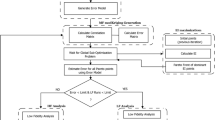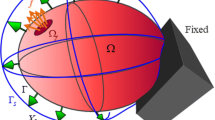Abstract
An automated optimization procedure based on successive response surface method is presented. The method is applied to weight optimization of a stiffened plate used in marine structures. In the design space the surrogate model is spanned sequentially into an optimally restricted subspace that is converging towards at least a local optimum. Both objective function and all constraint functions are modeled using linear response surface method enabling the use of a robust and efficient simplex algorithm for the optimizations. Special attention is paid to CAD and FEM-model linking that plays a central role in practical industrial applications. In this project SOLIDWORKS and ANSYS software are adopted for structural modeling and analysis, respectively, and the optimization is carried out in a MatLab environment. The reported results achieved in this project prove the robustness and effectiveness of the proposed approach.










Similar content being viewed by others
References
Abu-Odeh A-Y, Jones H-L (1998) Optimum design of composite plates using response surface method. Compos Struct 43:233–242
Acar E, Guler MA, Gerceker B, Cerit ME, Bayram B (2011) Multi-objective crashworthiness optimization of tapered thin-walled tubes with axisymmetric indentations. Thin-Walled Struct 49:94–105
Arai M, Shimizu T (2001) Optimization of the design of ship structures using response surface methodology. In: Wu Y-S, Cui W-C, Zhou G-J (eds) Practical design of ships and other floating structures. pp 331–339
Eldred MS, Dunlavy DM (2006) Formulations for surrogate-based optimization with data fit, multifidelity, and reduced-order models. In: Proceedings of the 11th AIAA/ISSMO Multidisciplinary Analysis and Optimization Conference, paper AIAA-2006-7117. Portsmouth, VA, 6-8 Sept
Gupta KC, Li J (2000) Robust design optimization with mathematical programming neural networks. Comput Struct 76:507–516
Heinonen O, Pajunen S (2011) Optimal design of stiffened plate using metamodeling techniques. J Struct Mech 44(3):218–230
Hock W, Schittkowski K (1981). Test examples for nonlinear programming codes. Lecture Notes in Economics and Mathematical Systems, 187. Springer
Huang Z, Wang C, Chen J, Tian H (2011) Optimal design of aeroengine turbine disc based on kriging surrogate models. Comput Struct 89:27–37
IACS (2009) Common Structural Rules for Bulk Carriers
Khuri AI, Cornell JA (1987) Response surfaces: design and analyses. Marcel Dekker Inc
Kleijnen JPC (2008) Response surface methodology for constrained simulation optimization: an overview. Simul Model Pract Theory 16:50–64
Montgomery DC (2001) Design and analysis of experiments. Wiley
Nemhauser GL, Laurence AW (1988) Integer and Combinatorial Optimization. Wiley
Park H-S, Dang X-P (2010) Structural optimization based on CAD-CAE integration and metamodeling techniques. Comput Aided Des 42:889–902
Queipo KN, Haftka RT, Shyy W, Goel T, Vaidyanathan R, Tucker PK (2005) Surrogate-based analysis and optimization. Prog Aerosp Sci 41:1–28
Ren W-X, Chen H-B (2010) Finite element model updating in structural dynamics by using response surface method. Eng Struct 32:2455–2465
Roux WJ, Stander N, Haftka RT (1998) Response surface approximations for structural optimization. Int J Numer Methods Eng 42:517–534
Sakata S, Ashida F, Zako M (2003) Structural optimization using Kriging approximation. Comput Methods Appl Mech Eng 192:923–939
Simpson TW, Mauery TM, Korte JJ, Mistree F (2001) Kriging models for global approximation in simulation-based multidisciplinary design optimization. AIAA J 39(12):2233–2241
Stander N, Craig KJ (2002) On the robustness of a simple domain reduction scheme for simulation-based optimization. Eng Comput 19(4):431–450
Yoo K-S, Eom Y-S, Park J-Y, Im M-G, Han S-Y (2011) Reliability-based topology optimization using successive standard response surface method. Finite Elem Anal Des 47:843–849
Acknowledgments
Support from the Finnish Metals and Engineering Competence Cluster (FIMECC) Innovations & Network- research and the research project Computational methods in mechanical engineering product development - SIMPRO are gratefully acknowledged.
Author information
Authors and Affiliations
Corresponding author
Rights and permissions
About this article
Cite this article
Pajunen, S., Heinonen, O. Automatic design of marine structures by using successive response surface method. Struct Multidisc Optim 49, 863–871 (2014). https://doi.org/10.1007/s00158-013-1013-7
Received:
Revised:
Accepted:
Published:
Issue Date:
DOI: https://doi.org/10.1007/s00158-013-1013-7




